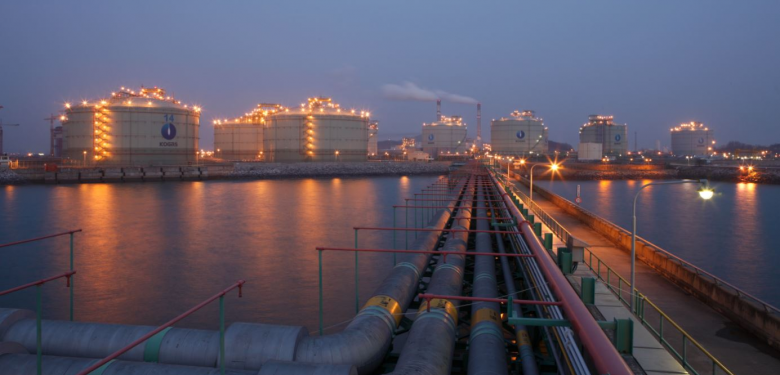
S.KOREAN LNG

PLATTS - South Korea aims to boost the portion of LNG in its electricity generation mix to 18.8% in 2030 from an estimated 16.9% this year as part of efforts to reduce its heavy reliance on coal and nuclear, the energy ministry said.
In its long-term Basic Blueprint for Power Supply and Demand, the Ministry of Trade, Industry and Energy said renewable sources would account for up to 20% of the power mix in 2030, up from an estimated 6.7% in 2017, by increasing investment in solar and wind power plants.
In contrast, coal's share in the power mix is slated to fall to 36.1% in 2030 from 45.3% in 2017, and nuclear to fall to 23.9% from 30.3% over the same period, according to the blueprint, which outlines the country's energy road map for 2017-2031.
The new plan puts more emphasis on issues related to the environment and safety, moving away from the stable supply and economic efficiency focus that the country has long given top priority, which has resulted in an over-reliance on coal and nuclear generation, the ministry said in a statement.
"When building new power plants, the government will reduce its heavy reliance on large nuclear power and coal plants and put higher priority on renewables and gas plants," the ministry said.
In terms of power generation capacity designed to meet peak demand, LNG will account for 38.6% in 2030, up from 34.7% in 2017, which will enable natural gas-fired power plants to be ready to raise operating rates in response to power supply shortages.
However, actual power production from gas is unlikely to reach 30% because the country's electricity reserves are expected to remain high due to sluggish demand and the government's push to cut consumption, a ministry official said.
The blueprint revised down the country's forecast of electricity demand to 100.5 GW in 2030 from the previous outlook of 113.4 GW, citing slowing economic growth.
South Korea will have ample electricity reserves of over 22% until 2030 to avoid any supply shortages due to disruption or malfunction at power plants, and the government's power policy will focus more on curbing demand than expanding supply, the official said.
REDUCE RELIANCE ON COAL
The new power mix plan is part of new President Moon Jae-In's efforts to lower the country's heavy reliance on coal and nuclear in electricity generation by raising power production from renewables and LNG.
Moon, who took office in May, has pushed to boost LNG's share of power production to around 37% by 2030 and initially sought to convert nine coal-fired power plants under construction to gas-fired ones.
But the government has since stepped back in the face of protests from the private utilities building the plants, with only one of the nine set to be converted to natural gas, according to energy minister Paik Un-gyu.
Instead, the government will impose higher taxes and tough environmental regulations on coal as part of efforts to prompt power generators to switch to natural gas, Paik told a forum last Friday.
The government will hike consumption taxes on coal to Won 36 ($0.03)/kg from next April from Won 30/kg currently and is mulling further tax adjustments to curb coal demand, he said.
-----
Earlier:

2017, November, 24, 09:05:00
S.KOREA'S SOLAR UPFT - OCI — the world’s third-largest polysilicon maker by capacity and South Korea’s biggest — this month reported a 3,373 per cent increase in operating profit to Won78.7bn ($72m) for the July-September quarter, its best performance in five years. Rival Hanwha Chemical saw third-quarter net profit jump 25 per cent to a record Won252bn. |

2017, June, 30, 08:30:00
U.S. - S.KOREA BUSINESSSouth Korean companies announced plans to import more American shale gas and build new factories in the U.S. as the two countries' leaders prepare to hold summit talks in Washington where trade is expected to be a key issue.
|

2016, August, 25, 18:35:00
THE LARGEST LNG IMPORTERSJapan, South Korea, and China are the three largest importers of liquefied natural gas (LNG) in the world, accounting for more than half of global LNG imports in 2015. Combined LNG imports in these countries averaged 18.2 billion cubic feet per day (Bcf/d) in 2015, a 5% (0.9 Bcf/d) decline from 2014 levels and the first annual decline in these countries' combined LNG imports since the global economic downturn in 2009.
|

2016, August, 19, 18:50:00
ASIAN LNG IMPORTS UPFive Asian countries (Japan, South Korea, China, India, and Taiwan) accounted for 68% of global LNG imports in 2015. In the first six months of 2016, in total, these five countries only increased their LNG import volumes by 1% (0.2 billion cubic feet per day (Bcf/d)), compared to the same period last year. However, higher imports in China and India more than offset declines in LNG consumption in the established markets of Japan and South Korea.
|

2016, February, 20, 20:55:00
ASIAN LNG DOWN 5%Total imports of liquefied natural gas (LNG) by Japan, South Korea, and China, the three largest global LNG importers, all located in North Asia, declined by an average of 1.0 billion cubic feet per day (Bcf/d) (5%) in 2015. |

2016, January, 28, 18:50:00
2016: ASIAN MARKET TROUBLEWith China's economy growing at its slowest pace in a generation and Asia's trading powerhouses Japan and South Korea struggling to create growth, Asian fuel oil demand for container ships should stagnate in 2016, putting more pressure on a market that struggled last year. |

2015, August, 2, 18:25:00
LNG IMPORTS DOWNImports of liquefied natural gas (LNG) in Japan, South Korea, and China, the three largest global importers, all located in the Asia Pacific region, have declined by an average 1.4 billion cubic feet per day (Bcf/d) (6.7%) in the first five months of 2015 compared to the same period in 2014. |




